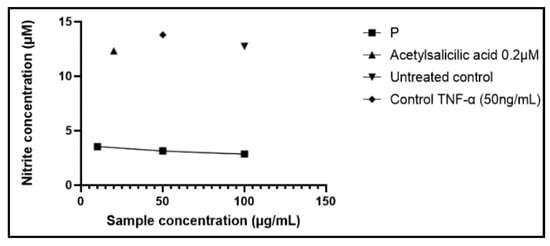Populus nigra L. (black poplar) (Salicaceae) is a deciduous tree widespread in Europe, Asia, Africa, and North America and found in meadows, wet depressions, streams, forests, plains, and low hills. The vegetal product has been described mainly to contain phenolic compounds, terpenoids, flavones, flavanones, and more than 48 phytocompounds in the essential oils [1]. The antioxidant and anti-inflammatory effects of poplar buds are widely known. This study aims at confirming these factors in a poplar-selective extract.
Preparation of extract: the vegetal material was extracted twice under reflux with 50% and 20% ethyl alcohol, and further, the extractive solutions were subjected to a liquid–liquid extraction with n-butyl alcohol. The combined butanolic solutions were evaporated to dryness (P fraction). Total polyphenolcarboxylic acids and flavones were spectrophotometrically quantifed [2]. For the determination of total antioxidant activity, the method of Prieto [3] was used, and nitric oxide (NO) production in endothelial cells was evaluated by the Griess colorimetric method [4].
Fraction P proves to have a strong antioxidant capacity with 5.57 mM ascorbic acid equivalent at 10 mg/mL (Figure 1). A line of human endothelial cells (HUVEC) was chosen to perform the experiment because several phases of the inflammatory process take place in the endothelium and, in addition, nitric oxide has an important role in modulating endothelial tone. The NO level in the cells treated with TNF-α is lowered by treatment with the P fraction (Figure 2).

Figure 1.
The total antioxidant capacity of the P fraction highlighted by the phosphomolybdenic acid method.

Figure 2.
The effect of L-fraction administration on NO production in endothelial cells under basal conditions and after TNF-α stimulation.
This study confirmed the antioxidant and anti-inflammatory potential of a selective fraction isolated from poplar buds.
Author Contributions
Conceptualization and writing, A.G.; technological studies, A.G.; chemical analysis, A.G.; in vitro studies, V.V. and G.N.; supervision, V.V. All authors have read and agreed to the published version of the manuscript.
Funding
This research was supported by The Executive Unit for Financing Higher Education, Research, Development and Innovation (UEFISCDI) in the frame of the project 563PED/2020.
Institutional Review Board Statement
Not applicable.
Informed Consent Statement
Not applicable.
Data Availability Statement
Not applicable.
Conflicts of Interest
The authors declare no conflict of interest.
References
- Kis, B.; Avram, S.; Pavel, I.; Lombrea, A.; Buda, V.; Dehelean, C.; Soica, C.; Yerer, M.; Bojin, F.; Folescu, R.; et al. Recent Advances Regarding the Phytochemical and Therapeutic Uses of Populus nigra L., Buds. Plants 2020, 9, 1464. [Google Scholar] [CrossRef] [PubMed]
- Farmacopeea Română, 10th ed.; Medicală: București, Romania, 1993.
- Prieto, P.; Pineda, M.; Aquilar, M. Spectrophotometric quantitation of antioxidant capacity through the formation of a phosphomolybdenum complex. Anal. Biochem. 1999, 269, 337–341. [Google Scholar] [CrossRef] [PubMed]
- Schleif, R.F.; Wensink, P.C. Methods in Molecular Biology; Nitric oxide protocol; de Titheradge, M., Ed.; Humana: Louisville, KY, USA, 2012; Volume 100. [Google Scholar]
Publisher’s Note: MDPI stays neutral with regard to jurisdictional claims in published maps and institutional affiliations. |
© 2022 by the authors. Licensee MDPI, Basel, Switzerland. This article is an open access article distributed under the terms and conditions of the Creative Commons Attribution (CC BY) license (https://creativecommons.org/licenses/by/4.0/).